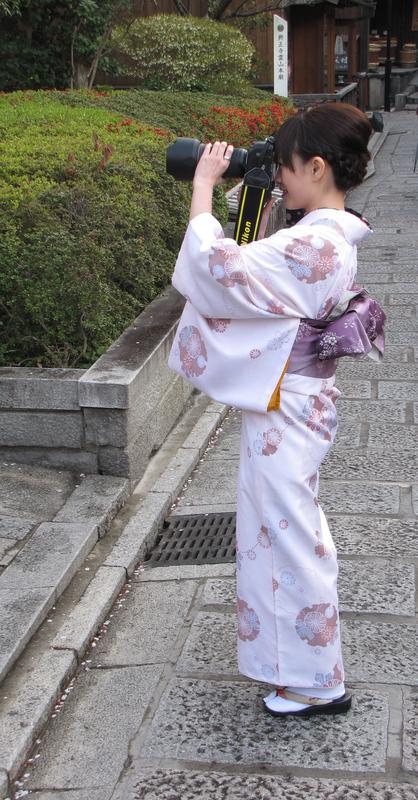On the recommendation of Lonely Planet I arrived at Nijo castle at 0900 (15 minutes after opening) to avoid the crowds - but the castle was already overrun by bus tour groups. Happily the groups had yet to reach the grounds, gardens, and fortifications - or were so spread out it didn't matter.
A particularly educational moment occurred when I was in a very dark corridor in the castle and I noticed daylight shining in through the floor boards. The castle is one storey, and the floor is about 80cm off the ground. The floors are also "nightingale" floors - they were built to squeak at every footfall to prevent unwanted visitors (and they do squeak).
The medieval Europeans never lived like this: the enclosure is huge, there's a second moated castle enclosure inside the first, and both include lovely gardens that make the ramparts almost invisible. It's a very, very different feel from European forts/castles. I don't know if the Japanese plan included letting the peasants in to protect them when the area was under attack.
I grabbed another cross-town bus, happily only about half an hour this time, to Kinkaku-ji temple. Those with good memory may note a similarity of name to Ginkaku-ji, which I visited a day or two ago. This is because Kinkaku-ji is the Gold Pavilion, and Ginkaku-ji was meant to be the Silver Pavilion - but unlike Kinkaku-ji, it was never painted. What makes this a star attraction isn't simply the gold leaf - although it's nice - it's the staggeringly photogenic pond and garden in front of it. Which co-incidentally gives all the tourists a clear and impossible to skank photo-op without other people in it - unless of course you want other people in it, which many do. Nothing else in the tour of the complex lives up to that opening shot, but there's a nice garden - and there's that awesome pond.
More bus and subway, now to southern Higashiyama - I wandered through northern Higashiyama a couple days ago. First stop was the Shoren-in temple, where intermittent light rain started, something that was to carry on for a couple hours. Mostly it's been quite lovely weather recently. At Shoren-in I got to really explore the inside of an old building (and be reminded again, by door frames about 178cm, that I'm a giant in this country). I love the idea of the walkways between buildings, the garden being part of the house - and it totally wouldn't hold up in Canada. Tatami mats and painted screens. Rice paper windows and sliding doors. Once you're done in the house, you can go out and explore the garden too.
Chion-in is just south of Shoren-in, and is definitely the most religiously active of any of the temples I've visited. Unfortunately, the main hall was under a massive shed for renovation through 2019. I went shoeless into one of the subtemples and sat down to listen to a monk chant. He was young and kept wiping his nose. The chant was incredibly mesmerising and I stayed there about 15 minutes until he was done. Then I followed the shoeless covered path between buildings to the main hall (the one under renovation), where I found myself invited to sit on the floor to listen to an in-progress Buddhist lecture by an older monk to a large audience of mostly older Japanese women and monks. At least ... I thought it was a Buddhist lecture - being in Japanese, I wasn't sure. But the audience was laughing so often I began to think I'd walked in on comedy hour - I stayed 15 or 20 minutes, and that assessment didn't change. It's one of the things I've always loved about Buddhism (particularly Zen Buddhism) - it doesn't take much of anything seriously.
I continued south, walking along Ninen-zaka - a lovely pedestrianised street of restored old houses. The houses are all food or trinket shops on this tourist avenue, but it's still quite lovely. There were a lot of people in formal dress there, especially women in kimonos: according to the guidebook, there are a number of places that rent them (for both genders) so you can walk around the temples and gardens looking beautiful.
photo: seen on Ninen-zaka

Then up the hill to Kiyomizu-dera, another famous temple. This one is best known for being built out of the hillside on a massive wood platform, and for its view of Kyoto. Very nice buildings too. I had a very pleasant walk around the compound.
To still the dispute back home - sake is served hot or cold most places in Japan, as per your preference (I've heard it argued that hot sake is a North American thing and it's served cold in Japan - but that doesn't seem to be true). I was trying to further research this question by going to a sake tasting, but 45 minutes was spent looking for a place recommended by the guidebook that doesn't seem to exist. I was at the location they named, but the sake place was not. I guess I was due for a failure: the guidebook has had a very good hit rate, in fact substantially better than the Rough Guide. Despite which I still prefer RG as its aesthetic sense generally matches mine better, ie. when they say a place is beautiful or a "must see," I'm more likely to agree with RG than LP.